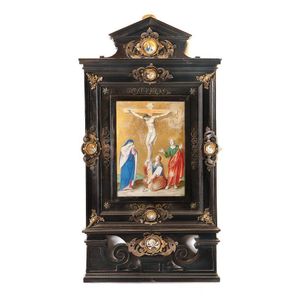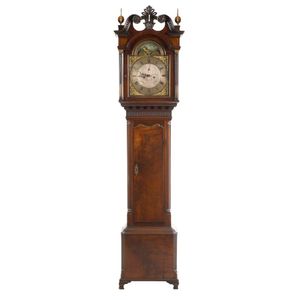Viennese Enamel & Bronze Ebony Jewelry Box
You must be a subscriber, and be logged in to view price and dealer details.
Subscribe Now to view actual auction price for this item
When you subscribe, you have the option of setting the currency in which to display prices to $Au, $US, $NZ or Stg.
- Ebony - Ebony is a close grained timber, black in colour. It has a fine texture which can be polished to a high gloss, making it suitable for venereering, inlay and stringing and its use as solid timber is resticted to small decorative items and ornamental decoration, such as chess pieces and musical instrument parts. The term "ebonised" means "faux ebony", timber that has been darkened during the polishing process to resemble ebony.
- Bronze - An alloy of copper and tin, traditionally in the proportions of about 9 parts of copper to 1 part of tin.
The discovery of bronze in Western Asia in the 4th century enabled people to create metal objects which were superior to those previoulsy possible because of its strength and hardness, and it has been used throughout the world for weapons, coins, tools, statuary and other decorative items.
It is very fluid in a molten state, and its hardness, strength when set, and non-corrosive properties makes it most suitable for casting sculpture. - Finial - An architectural decoration, found on the upper parts of of an object. On furniture they are usually found on pediments, canopies and shelf supports. On smaller ceramic or silver items, such as spoons, they may decorate the top of the item itself, or the lid or cover where they provide a useful handle for removal.
Finials have a variety of shapes and forms. They may be urn-shaped, baluster shaped round or spiral, but usually taper into an upper point. Many real life shapes may also be used as finials, such as pineapples, berries, pinecones, buds, lotus and acorns. Sometimes animals such as a lion are depicted, or fish and dolphins.
This item has been included into following indexes:
-
boxes, material or decoration
- bronze boxes 27
- enamelled boxes 172
Visually similar items

A fine Italian icon, late 18th/19th century, depicting the Crucifixion of Christ, with Mary Magdalene, John the Evangalist, and the Virgin Mary all with him at the foot of the cross, finely painted and mounted in an architectural ebony frame with silvered

A mahogany musical long case marquetry inlaid clock, circa 1880. 248 cm high, 51 cm wide, 34.5 cm deep

A mahogany longcase clock, by John Aspinwall Liverpool, circa 1800, circular silvered dial framed by pierced spandrels, foliate engraved centre with subsidiary seconds dial and concentric calendar, signed John Aspinwall, Liverpool. The upper arch displays

A George II musical organ bracket clock, Charles Clay, London, circa 1735, the large mahogany bell topped case with five gilt brass urn finials at each corner of the case and one located centrally on small reeded plinth. The case with full length pierced s
